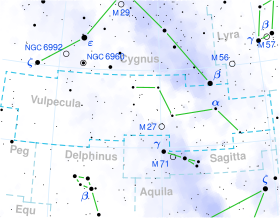13 Vulpeculae
Appearance
| Observation data Epoch J2000 Equinox J2000 | |
|---|---|
| Constellation | Vulpecula |
| Right ascension | 19h 53m 27.69557s[1] |
| Declination | 24° 04′ 46.6099″[1] |
| Apparent magnitude (V) | 4.57[2] |
| Characteristics | |
| Spectral type | B9.5III[2] |
| U−B color index | -0.13[3] |
| B−V color index | -0.06[3] |
| Astrometry | |
| Radial velocity (Rv) | -28.10[4] km/s |
| Proper motion (μ) | RA: +23.06[1] mas/yr Dec.: +36.28[1] mas/yr |
| Parallax (π) | 9.75 ± 0.54 mas[1] |
| Distance | 330 ± 20 ly (103 ± 6 pc) |
| Absolute magnitude (MV) | -0.48[2] |
| Details | |
| Luminosity | 180[2] L☉ |
| Temperature | 8,801[5] K |
| Metallicity [Fe/H] | -0.11[2] dex |
| Rotational velocity (v sin i) | 45.0[6] km/s |
| Other designations | |
| Database references | |
| SIMBAD | data |
13 Vulpeculae is a class B9.5III[2] (blue giant) star in the constellation Vulpecula. Its apparent magnitude is 4.57[2] and it is approximately 335 light years away based on parallax.[1]
It has one reported companion, B, with a magnitude of 7.37, a period of 615 years, and a separation of 1.55".[7]
References
- ^ a b c d e f Van Leeuwen, F. (2007). "Validation of the new Hipparcos reduction". Astronomy and Astrophysics. 474 (2): 653. arXiv:0708.1752. Bibcode:2007A&A...474..653V. doi:10.1051/0004-6361:20078357. Vizier catalog entry
- ^ a b c d e f g Anderson, E.; Francis, Ch. (2012). "XHIP: An extended hipparcos compilation". Astronomy Letters. 38 (5): 331. arXiv:1108.4971. Bibcode:2012AstL...38..331A. doi:10.1134/S1063773712050015. Vizier catalog entry
- ^ a b Mallama, A. (2014). "Sloan Magnitudes for the Brightest Stars". The Journal of the American Association of Variable Star Observers. 42: 443. Bibcode:2014JAVSO..42..443M.Vizier catalog entry
- ^ Gontcharov, G. A. (2006). "Pulkovo Compilation of Radial Velocities for 35 495 Hipparcos stars in a common system". Astronomy Letters. 32 (11): 759. arXiv:1606.08053. Bibcode:2006AstL...32..759G. doi:10.1134/S1063773706110065.
- ^ McDonald, I.; Zijlstra, A. A.; Boyer, M. L. (2012). "Fundamental parameters and infrared excesses of Hipparcos stars". Monthly Notices of the Royal Astronomical Society. 427: 343. arXiv:1208.2037. Bibcode:2012MNRAS.427..343M. doi:10.1111/j.1365-2966.2012.21873.x.
{{cite journal}}: CS1 maint: unflagged free DOI (link) Vizier catalog entry - ^ Glebocki, R.; Gnacinski, P. (2005). "VizieR Online Data Catalog: Catalog of Stellar Rotational Velocities (Glebocki+ 2005)". VizieR On-line Data Catalog: III/244. Originally published in: 2005csss...13..571G; 2005yCat.3244....0G. 3244. Bibcode:2005yCat.3244....0G. Vizier catalog entry
- ^ Malkov, O. Yu.; Tamazian, V. S.; Docobo, J. A.; Chulkov, D. A. (2012). "Dynamical masses of a selected sample of orbital binaries". Astronomy & Astrophysics. 546: A69. Bibcode:2012A&A...546A..69M. doi:10.1051/0004-6361/201219774. Vizier catalog entry
External links
- 13 Vulpeculae on WikiSky: DSS2, SDSS, GALEX, IRAS, Hydrogen α, X-Ray, Astrophoto, Sky Map, Articles and images

